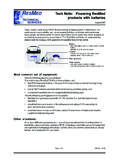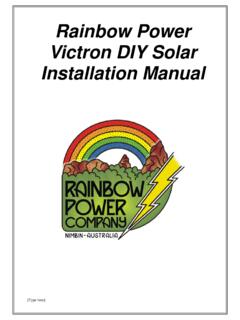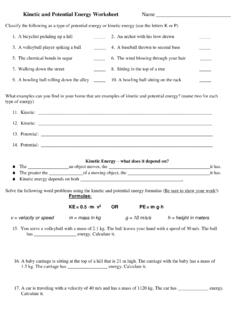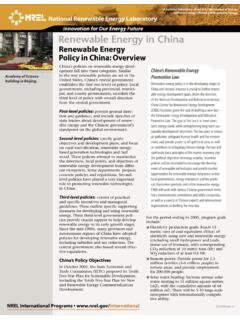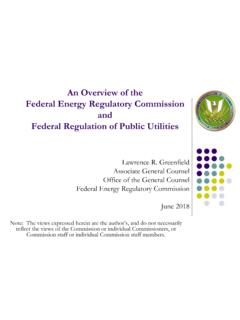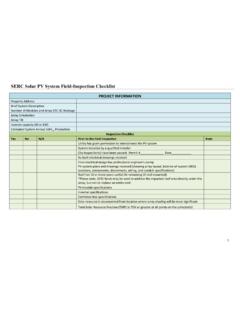Transcription of WIND TURBINE POWER, ENERGY, AND TORQUE
1 Chapter 4 Wind TURBINE Power 4 1. WIND TURBINE POWER, energy , AND TORQUE . Who has gathered the wind in his sts? Proverbs 30:4. Gathering or harvesting the wind has been of concern to man for a long time. As mentioned earlier, wind turbines have been used for several centuries and literally millions of units have been put into service. For the most part, these machines performed their intended purpose well, and in many cases were still being used with minimum maintenance after half a century of service. Operational machines four centuries old are not unheard of, pointing out the fact that planned obsolescence does not have to be a part of engineering work. A major reason for their success was the lack of competition, of course.
2 There was a choice of using the wind to perform some task or doing it by hand, and doing it by hand is last choice for most people. Today, wind turbines have to compete with many other energy sources. It is therefore important that they be cost e ective. They need to meet any load requirements and produce energy at a minimum cost per dollar of investment. Performance characteristics such as power output versus wind speed or versus rotor angular velocity must be optimized in order to compete with other energy sources. Yearly energy production and its variation with annual wind statistics must be well known. The shaft TORQUE must be known so the shaft can be built with adequate strength and the TURBINE load properly sized.
3 We shall examine such performance characteristics in this chapter. 1 POWER OUTPUT FROM AN IDEAL TURBINE . The kinetic energy in a parcel of air of mass m, owing at speed u in the x direction is 1 1. U = mu2 = ( Ax)u2 Joules (1). 2 2. where A is the cross-sectional area in m2 , is the air density in kg/m3 , and x is the thickness of the parcel in m. If we visualize the parcel as in Fig. 1 with side x moving with speed u and the opposite side xed at the origin, we see the kinetic energy increasing uniformly with x, because the mass is increasing uniformly. The power in the wind, Pw , is the time derivative of the kinetic energy : dU 1 dx 1. Pw = = Au2 = Au3 W (2). dt 2 dt 2. This can be viewed as the power being supplied at the origin to cause the energy of the parcel to increase according to Eq.
4 1. A wind TURBINE will extract power from side x, with Eq. 2. representing the total power available at this surface for possible extraction. Wind energy Systems by Dr. Gary L. Johnson November 21, 2001. Chapter 4 Wind TURBINE Power 4 2. y 6. A. - u - x z Figure 1: Packet of air moving with speed u An expression for air density is given in Chapter 2 and is repeated here for convenience: p = kg/m3 (3). T. In this equation, p is the pressure in kPa and T is the temperature in kelvin. The power in the wind is then 1 Pw = Au3 = W (4). 2 T. where A is area in square meters and u is wind speed in meters per second. For air at standard conditions, kPa and 273 K, this reduces to Pw = W (5). The more general Eq. 4 should be used whenever the wind TURBINE elevation is more than a few hundred meters above sea level or the temperature is signi cantly above 0o C.
5 At standard conditions, the power in 1 m2 of wind with a speed of 5 m/s is (5)3. = 81 W. The power in the same 1 m2 of area when the wind speed is 10 m/s is 647 W. This illustrates two basic features of wind power. One is that wind power is rather di use. It requires a substantial area of wind TURBINE to capture a signi cant amount of power. The other feature is that wind power varies rapidly with wind speed. Overspeed protection devices are therefore required to protect both the TURBINE and the load at high wind speeds. The physical presence of a wind TURBINE in a large moving air mass modi es the local air speed and pressure as shown in Fig. 2. The picture is drawn for a conventional horizontal axis propeller type TURBINE .
6 Wind energy Systems by Dr. Gary L. Johnson November 21, 2001. Chapter 4 Wind TURBINE Power 4 3. Figure 2: Circular tube of air owing through ideal wind TURBINE . Consider a tube of moving air with initial or undisturbed diameter d1 , speed u1 , and pressure p1 as it approaches the TURBINE . The speed of the air decreases as the TURBINE is approached, causing the tube of air to enlarge to the TURBINE diameter d2 . The air pressure will rise to a maximum just in front of the TURBINE and will drop below atmospheric pressure behind the TURBINE . Part of the kinetic energy in the air is converted to potential energy in order to produce this increase in pressure. Still more kinetic energy will be converted to potential energy after the TURBINE , in order to raise the air pressure back to atmospheric.
7 This causes the wind speed to continue to decrease until the pressure is in equilibrium. Once the low point of wind speed is reached, the speed of the tube of air will increase back to u4 = u1. as it receives kinetic energy from the surrounding air[3]. It can be shown[2] that under optimum conditions, when maximum power is being trans- ferred from the tube of air to the TURBINE , the following relationships hold: 2. u2 = u3 = u1. 3. 1. u4 = u1. 3. 3. A2 = A3 = A1 (6). 2. A4 = 3A1. Wind energy Systems by Dr. Gary L. Johnson November 21, 2001. Chapter 4 Wind TURBINE Power 4 4. The mechanical power extracted is then the di erence between the input and output power in the wind: 1 1 8. Pm,ideal = P1 P4 = (A1 u31 A4 u34 ) = ( A1 u31 ) W (7).
8 2 2 9. This states that 8/9 of the power in the original tube of air is extracted by an ideal TURBINE . This tube is smaller than the TURBINE , however, and this can lead to confusing results. The normal method of expressing this extracted power is in terms of the undisturbed wind speed u1 and the TURBINE area A2 . This method yields 1 8 2 1 16. Pm,ideal = [ ( A2 )u31 ] = ( A2 u31 ) W (8). 2 9 3 2 27. The factor 16/27 = is sometimes called the Betz coe cient. It shows that an actual TURBINE cannot extract more than percent of the power in an undisturbed tube of air of the same area. In practice, the fraction of power extracted will always be less because of mechanical imperfections. A good fraction is 35-40 percent of the power in the wind under optimum conditions, although fractions as high as 50 percent have been claimed.
9 A TURBINE which extracts 40 percent of the power in the wind is extracting about two-thirds of the amount that would be extracted by an ideal TURBINE . This is rather good, considering the aerodynamic problems of constantly changing wind speed and direction as well as the frictional loss due to blade surface roughness. It is interesting to note that the total pressure di erence across the TURBINE is rather small. For a 6 m/s wind speed, p2 will be about Pa greater than p1 , while p3 will be about Pa less. The pressure di erence is then about percent of the ambient pressure. Small pressure di erences are therefore able to provide rather substantial TURBINE power outputs. 2 AERODYNAMICS. Air ow over a stationary airfoil produces two forces, a lift force perpendicular to the air ow and a drag force in the direction of air ow, as shown in Fig.
10 3. The existence of the lift force depends upon laminar ow over the airfoil, which means that the air ows smoothly over both sides of the airfoil. If turbulent ow exists rather than laminar ow, there will be little or no lift force. The air owing over the top of the airfoil has to speed up because of a greater distance to travel, and this increase in speed causes a slight decrease in pressure. This pressure di erence across the airfoil yields the lift force, which is perpendicular to the direction of air ow. The air moving over the airfoil also produces a drag force in the direction of the air ow. This is a loss term and is minimized as much as possible in high performance wind turbines. Wind energy Systems by Dr. Gary L.


